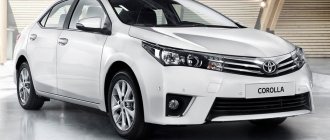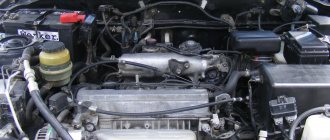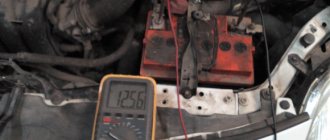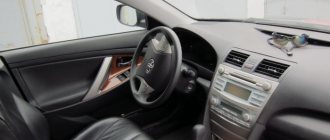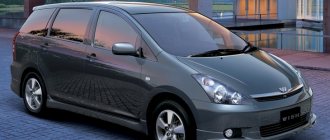In 2011, Toyota continued to develop the Prius model and introduced the world to the subcompact hatchback Prius C, which surprised with its ergonomics and efficiency. In 2015 and 2021, the model was restyled: its appearance became more attractive and sporty, leaving all the better features.
You might be interested
Here you can learn more about another hybrid - the Toyota Prius V
Exterior of Toyota Prius C hybrid
The appearance of the Toyota Prius C combines conservatism and style. The radiator grille is made in the shape of a trapezoid. The bumper turned out to be slightly “convex” with a protruding bottom. The image is complemented by LED headlights with a regular triangular shape and rounding.
Left view of Toyota Prius C
The profile is distinguished by a sloping windshield and a neatly curved roof, at the end of which a “fin” is installed. The rear part received a concave trapezoidal door and large LED headlights. The bumper is slightly raised.
Back view
Body dimensions: length – 4.0 m, width – 1.694 m, and height – 1.445 m.
Second generation Toyota Prius, XW20 body (2003-2009)
The old Toyota Prius was updated in 2002, and the very next year the world saw an updated hybrid with more advanced characteristics and a new design.
XW20 design
The appearance of the 2nd generation model has improved significantly. The radiator grille has expanded slightly and organically fits into the design. The lower bumper has been slightly redesigned and now features round LED headlights. The head optics also changed their appearance, becoming trapezoidal. The body looks like one piece.
Toyota Prius 20 body, second generation side view
The roof of the car has become more streamlined with a neat curve. Familiar contours appeared at the rear - a massive trunk lid with a continuation in the form of a spoiler and large headlights located along the edges of the body.
Toyota Prius 20 body, 2nd generation front view
The interior of the second generation has become a little more spacious, and the upholstery is of better quality. The multimedia system received a 7-inch display. Below was a transmission lever, similar to a joystick. The seats could be upholstered in velor or leather. The front row has been raised slightly, providing the driver with better visibility.
Salon Toyota Prius 20, second generation
Technical characteristics of Toyota Prius in body 20, second generation
The filling of the hybrid has been modernized. The same 1NZ-FXE engine now has 77 hp. and 115 Nm of torque. The electric motor power was increased to 50 kW, and the torque was already 400 Nm. Fuel consumption was approximately 5.5 liters.
Hybrid engine
The nickel-metal hydride battery retains a capacity of 6.5 Ah. Now it consists of 20 high-capacity modules. Withstands up to 1500 charge/discharge cycles.
The car is now capable of switching to EV mode - you can enjoy driving on electricity for 2-3 km. Speed is limited to 20 km/h.
You might be interested
You will learn more about the model here - Second generation Toyota Prius, body 20
Interior of Toyota Prius C hybrid
The interior equipment looks modern and interesting. Under the windshield there is an asymmetrical panel with a matte black frame. The display diagonal is 3.5 inches. This familiar feature of all new Priuses remains unchanged.
Dashboard
Just below there is a large 6.1-inch display of the multimedia system. Function keys are installed along the edges. At the bottom of the dashboard there is an automatic transmission lever.
Toyota Prius C front console
The salon is designed for 5 people. The front seats have lateral support and a small range of adjustment. The back row is a 3-seater sofa, but for three people it will be a bit cramped. The volume of the luggage compartment is 484 liters.
Toyota Prius models
The production of Toyota Prius started in 1997. The main models include:
- NHW10 - first generation (Prius-1). This model was sold only in the Japanese automobile market. Year of manufacture (1997-2000).
- NHW11 - rebranding of the first generation (Prius-1.1). Sales began in 2000 and continued for the next three years.
- NHW20 - second generation (Prius-2). In 2003, a new version of the Toyota Prius appeared on the market, which remained on the assembly line until 2011.
- ZVW30 - third generation (Prius-3). The issue was launched in 2009.
- ZVW35 - third generation (Prius-3 PHV) The model entered production in 2012 and is produced to this day.
- ZVW40 and ZVW41 - third generation (restyling). Start of production - 2011. The difference between the two mentioned options is the number of seats. In the first case, it is a 7-seater, and in the second, a 5-seater station wagon.
- Toyota Prius 4th generation - debuted in September 2015. There is still little complete information about this car, so we will tell you about it a little later.
Type of hybrid installation
The updated model uses the front-wheel drive Toyota B platform with the THS-II hybrid system. The front axle has independent McPherson struts, and the rear has trailing arms with a semi-independent layout.
Toyota Prius C Hybrid Engine
The 3rd generation Synergy Drive hybrid system consists of an internal combustion engine, a traction electric motor (as well as a motor-generator) and a VVB. The generated torque from the hybrid engine passes through a planetary gear. As a result, energy goes not only to the wheels, but is also spent on rotating the generator. The battery stores charge, which can be replenished using the regenerative braking function.
The total power of the hybrid power plant is 100 hp.
You might be interested
You can learn about how hybrids are structured and work in this article - How a Hybrid Works
Hybrid car device
Let's try to figure out how, with increased power, a car can consume gasoline at the level of a small car. The Toyota Prius hybrid car consists of:
- internal combustion engine (ICE);
- electric motor;
- planetary gearbox (power divider);
- generator;
- inverter;
- battery.
The internal combustion engine and the electric motor can operate simultaneously, alternately and complement each other if necessary. In a hybrid device, torque can be transmitted directly to the wheels from the electric motor and internal combustion engine in various proportions.
This is done using a planetary gearbox (power divider), which consists of a set of gears. Four of them are connected to a gasoline engine, and the outer one is connected to an electric motor. Another satellite is connected to a generator, which, if necessary, sends energy to the electric motor or charges the battery.
One of the main advantages of the Prius is that, unlike electric vehicles, charging a hybrid car does not require a power connection. The processor, which controls all the actions of the machine, recharges the battery from the internal combustion engine if necessary.
Description of the operating modes of the hybrid power plant
In total, the updated Prius C hybrid offers 4 operating modes:
1. EV mode
The car runs on electric power only. Use is limited by possible speed and distance.
2. ECO mode
The machine mainly uses electric propulsion. If there is a lack of traction, the internal combustion engine turns on. The use of regenerative braking is important.
3.Normal
Standard driving mode. Electricity is used at start and in areas where low speed is needed.
4. Power mode
All the power of the two motors is directed to the movement of the hybrid. Characterized by high dynamics and high flow rates.
How a hybrid car works
The main task of Toyota engineers was to create an economical car that would not be inferior to powerful “iron horses” on the track, but at the same time would have low engine consumption. For this, a combination of an internal combustion engine and an electric motor was used. To achieve maximum efficiency, in the Toyota Prius both power sources can operate separately, together and in parallel.
So, the operating principle of the hybrid Toyota Prius. The engine is started and the car accelerates using a traction electric motor. It rotates the external satellite of the planetary gearbox and thus transmits torque to the wheels. But you won't get far on a battery. Therefore, as soon as the car picks up speed, the internal combustion engine comes into play.
The combined use of an electric motor and an internal combustion engine makes it possible to achieve maximum efficiency (efficiency) of the entire system, because. When you press the brake, the internal combustion engine turns off and so-called regenerative braking occurs (all the energy from the resistance is converted into electricity), during which the electric motor, operating in generator mode, charges the battery.
If the car again requires increased power, for example for overtaking, the electric motor is switched on again, the energy of which is quite enough for a sharp increase in speed. The operation schemes of hybrid cars were designed to increase vehicle efficiency and reduce carbon dioxide emissions into the atmosphere. When fuel consumption increases (when you press the gas pedal), the control computer sends a signal to the power divider and turns on the electrical source, which allows the internal combustion engine to operate in no-load mode.
Toyotas have unique reliability and flexibility, since motion control is mostly done by wire, bypassing the use of complex components and assemblies. By the way, in the Toyota Prius hybrid, the generator acts as a starter and helps to “spin” the internal combustion engine to the required 1000 rpm.
Engine operating mode
- Start. Moving using only electric traction.
- Movement at constant speed. In this case, torque is transmitted to the generator and wheels.
- The generator, if necessary, recharges the battery and transfers energy to the electric motor. In this case, the torques of both traction units are summed up.
- Forced mode. The electric motor, receiving additional power from the generator, enhances the power of the gasoline engine.
- Braking. The hybrid brakes mostly using an electric motor. However, when you press the pedal hard, the hydraulic units are activated and braking occurs in the usual way.
Technical characteristics of Toyota Prius C
Restyling did not affect the technical characteristics of the car; they remained the same. Fully consistent with the compact hybrid.
Below are the main characteristics.
| Transmission | continuously variable CVT |
| Ground clearance | 140 mm |
| Distance between front and rear wheels | 2550 mm |
| Turning radius | 4.8 m |
| Front and rear track width | 1481/1476 |
| Fuel tank capacity | 36 l |
| Wheel size | 17/65 R15 |
| Vehicle weight | 1,134 t |
| Brakes | ventilated disc/disc |
| Tire size | 175/65 R15 |
Reference! The spare wheel is located in the luggage compartment niche.
Gas engine
Toyota Prius C is equipped with a 1.5-liter 1NZ-FXE engine with 4 cylinders. Power – 73 hp at 4800 rpm. Torque reaches 111 Nm.
The engine operates according to the Atkinson cycle. It has an installed gas distribution system with variable phase control and distributed fuel injection.
Electric motor
The electric traction motor has a power of 45 kW and a torque of 169 Nm. Powered by a high voltage battery. Depending on the selected mode, it can work in single mode, as well as in conjunction with the internal combustion engine.
An additional small motor-generator has a power of 18 kW. It does not participate in the movement process and is an auxiliary equipment of the system that generates electricity.
Battery and mileage on one charge
The Prius C hatchback has a nickel-metal hydride battery pack. Engineers placed it under the rear seat so as not to reduce trunk volume.
Technical data of the VVB block:
Voltage – 144 Volts, storage energy – 0.94 kWh. The number of charge/discharge cycles reaches 1500.
There is also a regular 12-Volt battery designed to power the on-board system.
On one charge the car can travel a maximum of 1.5-2 km. Travel speed does not exceed 45 km/h.
A new high-voltage battery costs around 63,000 rubles.
Front view
First generation Toyota Prius, XW10 body (1997-2003)
The Prius was first introduced in 1997 in Tokyo. A little later, the first generation moved to the European market. This model was the only hybrid at that time that went into mass production.
XW10 design
There is nothing to talk about design excellence in the early 2000s. The front features simple triangular-shaped headlights with rounded edges. The small radiator grille is divided into two parts by the emblem. At the bottom of the bumper, in the center, there is a double grille air intake.
Toyota Prius 1st generation body 10th front view
The car's profile has an angular shape with a long hood line and a sharp slope towards the trunk. At the rear there is also a pair of rounded headlights, breaking off their shape at the junction with the trunk. The rear bumper is slightly raised.
Toyota Prius body 10, 1997-2003
Inside, a 5.9-inch multimedia screen awaited us, showing basic information.
Toyota_Prius body 10, 1st generation interior
The front panel moved to the top of the dashboard, where it remains to this day. This solution made it possible not to be distracted from the road while looking at the speedometer and fuel consumption. The salon is designed for 4 people.
Dashboard and multimedia
Technical characteristics of Toyota Prius 10, first generation
The 1st generation Prius uses a parallel installation design. This means that the electric motor acts as an auxiliary unit. Collaboration with the internal combustion engine is carried out by connecting them with a planetary gearbox.
Hybrid engine
The car is equipped with a 1NZ-FXE four-cylinder petrol engine with a volume of 1.5 liters. The engine power is 58 hp and the torque is 102 Nm. Fuel consumption in the city could reach up to 6 liters.
The electric motor has 30 kW of power and 305 Nm of torque. It is powered by a nickel-metal hydride battery with a capacity of 6.5 Ah. It consisted of 40 blocks of 6 batteries each. The installed inverter limited the energy supplied for charging to a voltage of 13.8 Volts.
The first Prius could reach a speed of 150 km/h. Acceleration to “hundreds” was 17 seconds.
Of the safety systems, there was only a set of airbags, as well as ABS and EBD systems.
Fuel consumption per 100 km and dynamics of Toyota Prius C
You shouldn't expect sports car performance from the Prius C. Top speed is limited to 175 km/h, and acceleration from 0 to 100 km/h takes 10.7 seconds. Not bad for such a hatchback.
On the highway, 4.4 liters of fuel will be consumed. In the city, the figure will increase to 5.1 liters. In the combined cycle, consumption will be 4.7 liters of fuel per 100 km.
The note. There is no significant difference between the declared and actual consumption. The differences will be no more than a liter, and depend primarily on the condition of the car and road conditions.
Features and Specifications
Toyota Prius is a popular “hybrid” in wide circles. As mentioned above, production of the car was launched in 1997.
Then everything developed as follows:
1. First models NHW10/11.
It had an electric motor with a power of 30 kW and a battery with a capacity of 6 Ah. The gasoline engine boasted a volume of one and a half liters and a power of 58 hp. The car accelerated to “hundreds” in 15.5 seconds.
The operating principle of the hybrid is as follows:
- The gasoline engine only works to charge the battery, and the electric motor is responsible for the movement of the vehicle (sequential operating mode);
- Any of the motors (gasoline or electric) is responsible for the movement of the car. This type of control is considered optimal.
2. Second model NHW20.
Belong to the second generation. It works on a similar principle. The power part of the car is called Toyota Hybrid Synergy Drive. It consists of a 1.5-liter gasoline engine with a power of 76 hp. and an electric motor with a power of 68 hp.
Total power - 116 “horses”.
The main achievement of the new model was minimal harmfulness. CO2 emissions in combined mode were just 104 g/km.
The car's economy deserves special attention. The average fuel consumption in the city is 8 liters, and when driving on the highway - 5.5 liters.
The new Hybrid Sinergy Drive has the following operating modes:
- The movement is started by an electric motor powered by a battery. After gaining speed, the gasoline engine comes into operation, and the electric motor goes into standby mode;
- In the case of active acceleration, the two types of motor work together to achieve maximum power;
- Uniform movement is characterized by the active operation of the electric motor. In this case, the gasoline engine is switched off. If the battery charge level drops below the permissible level, the computer starts the motor to replenish the lost capacity.
A special feature of the Prius II is its richness in electronics, such as ABS, VSC and EBD, as well as the presence of an economical electric drive that operates the car's air conditioning.
The body of the car has also changed, which has turned from a classic sedan into a hatchback.
Despite the external changes, the transport did not impress buyers. When creating the second version, the manufacturer was no longer chasing beauty.
The goal was to make trips as comfortable as possible for the driver and passenger.
The salon is spacious and unique in style. The instrument panel is perfectly designed. An LCD monitor of the on-board computer is installed in the central part.
A diagonal of 14.5 centimeters is enough to see the information on the screen even with poor eyesight.
The main information transmitted by the on-board computer is fuel consumption, power distribution between the battery, wheels and engine, remaining fuel, and more. Information is updated every five minutes.
3. Prius-3 (ZVW30/35).
Appeared in 2009. It was this generation of the car that provided the model with worldwide recognition.
The developers were faced with the task of preserving the originality of previous versions and making a number of additions.
The new car has become longer and wider (by 1.5 and 2.0 centimeters, respectively). As for the length of the wheelbase and the height of the body, they remained unchanged.
The appearance of the car has also changed. Now the rear and front headlights seem to be united with each other, thanks to the insignificant at first glance, but harmoniously looking stripes on the sides of the body.
An important feature for passengers was the shift of the highest point of the body to the central part of the cabin. Now, even with a height of 1.7 meters and above, you can feel comfortable and not be afraid of hitting your head. The passenger and driver's seats became three centimeters thinner, and there was more room for knees.
The gearshift knob also changed its position. The handle was moved from the dashboard, where it was previously located, to a higher elevation in the center console.
Buyers now have the opportunity to choose wheel diameters - between 15 and 17 inches.
In the third version of the Toyota Prius, small protrusions appeared to provide better control of the vehicle's air flow. In comparison with the second version, the air resistance coefficient decreased by 0.01 (from 0.25 to 0.24).
The power part of the car has also undergone major changes. Instead of a 1.5-liter gasoline engine, a 1.8-liter engine with a power of 99 horsepower took the reins.
The decision to increase the engine size was caused by the desire of the developers to reduce fuel consumption when driving the car at high speeds.
The total power when operating an electric and gasoline engine is 136 horsepower. The car accelerates to “hundreds” in 10.4 seconds.
The electric motor now features a planetary gearbox, complemented by a heat recovery system and an oil pump.
Additional operating modes have been added. So, instead of one “EV Mode”, when the car was driven only by electric traction, two more options appeared:
- “Power Mode” - a mode designed for traveling at high speeds;
- “ECO Mode” is an economical option designed for reduced fuel mixture consumption.
In normal mode, fuel consumption averages 4 liters per hundred. When switching to the eco-option, it drops to 1.75 liters.
4. Restyling of Prius-3 (ZVW40 and ZVW41).
In 2011, the world saw a new restyled version of the already beloved third Prius.
The designers made no changes to the power unit, focusing on the appearance and interior of the car.
Thus, LED sections appeared in the head optics, the air intake opening was enlarged, and the interior trim was changed (the quality of the material used improved).
A number of devices have changed locations on the dashboard. The Japanese paid more attention to sound insulation.
The suspension also underwent design changes, which became stiffer.
The power unit remains unchanged - the same 1.8-liter gasoline engine paired with an electric motor producing 82 horsepower.
Fuel consumption in the combined cycle is 3.9 liters per “hundred”. In addition, the new model has “learned” to drive only on electric power.
Hybrid reliability, breakdowns
Toyota Prius C is equipped with Safety Sense 2.0.
Its composition includes:
- ABS, BAS, EBD, TCS systems;
- electronic stability control;
- assistant for ascent and descent;
- lane control;
- emergency braking function in the presence of obstacles;
- special lighting at night;
- full set of airbags.
The car has the following advantages: efficiency, roomy interior, compactness, rich basic equipment.
There are also disadvantages: poor sound insulation at speed, slow acceleration, cheap materials in the cabin.
The only breakdown worth noting is leaking headlights. Sometimes the seal is broken. And water gets there. Replacing or using special sealing agents will help.
Third generation Toyota Prius, XW30 body (2009-2015)
In 2009, Toyota introduced the 3rd generation. In 2011, a restyling was carried out, as a result of which the car became even more attractive and sporty in appearance.
XW30 design
The headlights of the third generation Toyota Prius have a complex shape and are equipped with LED lights. The hood received a slight undulation in the direction from the emblem to the windshield. The bumper, in addition to a large air intake, has shaped recesses on the sides. Fog lights are hidden in them.
Toyota Prius ZVW30, third generation front view
The roof line has been slightly lengthened due to the installed spoiler. The rear optics are also LED. The aerodynamics of the car in its new look have improved significantly.
The interior decoration was complemented by a 6-inch diagonal LCD monitor. Safety is now covered by a full-fledged Safety Sense system, complemented by new functions (adaptive road lighting, electronic stability control).
Toyota Prius interior body 30, third generation
Technical characteristics of Toyota Prius in body 30, third generation
The engine has been updated. Now in place of the old engine is a four-cylinder 2ZR-FXE with a volume of 1.8 liters. Power is 98 hp and torque is 42 Nm.
The electric motor can produce a maximum of 60 kW. Torque – 207 Nm. The battery power is 1.3 kWh. The capacity is the same - 6.5 Ah. Operating voltage – 200 Volts. The electric range remains the same – 3 km.
Hybrid engine
Fuel consumption is kept within 3.9 liters per 100 km in the combined cycle.
You might be interested
You will learn more about the model here - Third generation Toyota Prius, body 30
Operation in winter
The hybrid engine does not experience difficulties in winter. The cabin is warm - activation of the internal combustion engine turns on the stove, which warms it up to an acceptable temperature in 2-3 minutes.
The battery withstands frosts. But if it already has a fair amount of wear, then the modules often fail. A partial replacement will help.
Important! Do not leave the car idle for more than 5-7 days. The battery may not withstand idle time. In winter, park your Prius C in a heated garage or parking lot.
Back view
Options and prices of Toyota Prius C
The updated Toyota Prius C comes in 4 trim levels: One (standard), Two, Three, Four. All trim levels are equipped with the proprietary Safety Sense 2.0 safety system.
The initial configuration is described in the article. Its price is 1,500,000 rubles.
Version Two includes:
- dividing armrests;
- seat adjustment in 6 directions;
- audio system with 6 speakers;
- immobilizer
The cost starts from 1,720,000 rubles.
The top-end Three and Four trim levels additionally include:
- power sunroof;
- intelligent parking assistance system;
- voice controlled navigation.
The cost will be from 1,910,000 rubles.
New Toyota Prius 2021: photo and price, hatchback characteristics
In Russia, not everyone has yet embraced the idea that hybrid and electric cars are ideal means of transportation in the city. This is largely due to the fact that we simply do not have the conditions for such machines. However, in Europe and other parts of the world, electric cars are in great demand.
One of the most popular electric cars is the Toyota Prius. Next year the model will receive another restyling. The new body of the 2021 Toyota Prius will acquire a beautiful appearance, thanks to which you can easily stand out among other cars, plus the model will receive a bunch of modern options.
Navigation
Pros and cons of Toyota Prius
+ Pros
- Design
- Reliability
- Salon
- Controllability
- Dynamics
- Trunk
- Minuses
- Patency
- Noise insulation
- Build quality
- Economical
Reviews from Toyota Prius owners
You can’t call the suspension a hard one, it’s more soft than hard, sometimes on big bumps you get the feeling that you’re rocking like in a boat, but it behaves predictably.
Consumption: During the 30 km test drive that I drove, the average consumption was 3.6 liters. For the entire 800 km that she drove, the average consumption was 4.5 (she drove half on the highway, where they say she eats the most). For Europe, the car will cover 100,000 km. You can also look at the photo, the car is being run in, we’re not used to driving economically, so that’s how it is for now! The tank contains 100 octane gasoline.
What can I say, the Prius fully justified all my hopes. With its main task: sat down, started it and went where needed, regardless of the distance, it copes with 5+. In fact, the car in its price segment is simply classy. Trips around the city and region so far; I have driven only 8,500 km in a year. Diagnostics of the chassis on a PC and a visual check of changes in its condition did not reveal...
It is large, roomy and comfortable. The seats all move back and forth, the backrest is adjustable, and the driver's seat has a lift and adjustable lumbar support. The heated front seats are switched on at the very bottom of the center stack, next to the power outlet, and have only one temperature setting. There is no cigarette lighter or ashtrays. Rear passengers have air at their feet, 5 cup holders, in each door there is a niche with a compartment for a 1l bottle. The trunk is roomy, with many hidden drawers. There is an umbrella pocket behind the rear seats.
About the ride. A very cool feature is the choice of driving mode. Three buttons on the armrest: Electro, Power, Eco. And not pressed at all. The selected mode is displayed on the instrument panel. Eco - it drives with difficulty, it’s dull, but if you press the gas longer, it becomes more playful. Without the mode - 10 more forces than Eco. Power - moderately presses into the seats, quickly picks up power and speed and turns all the way. Costs in the city are minimum - the maximum is 3.6 liters - 4.5 liters, the same on the highway.
It is impossible to give a serious analysis after 5 months of operation, but nevertheless. The first thing I would like to note is reliability. Everything is simple and modern, it works like a clock. Engine, chassis, opening and closing doors, hood, trunk, navigation, music, etc. Cost-effectiveness is within the stated limits. Realistically 5 liters per 100 km in the city. The appearance is cosmic! Super modern car! Everyone is still looking at him!
Low gasoline consumption. At first I looked at the mileage for one fill-up. Once I drove 941 km on 40 liters of gasoline. Tank volume 42 liters. Once I was driving home from work (22 km), gasoline consumption was 2.8 l/100 km. It varies - from 3.3 liters to 5. Good sound system. Large trunk. There is enough legroom in both the front and rear seats.
Reviews from Toyota Prius car owners with photos on drom.ru, drive2.ru, auto.ru and auto.mail.ru
Toyota Prius 2021 prices and specifications
The price of Toyota Prius 2021 in Russia is 2,322,000 rubles; the hybrid hatchback is offered in the Luxe configuration.
| Equipment | price, rub. |
| 1.8h (122 hp) Luxe CVT | 2 322 000 |
* h - hybrid, CVT - variator
Technical characteristics of Toyota Prius XW50
Body
| Body type | hatchback |
| Car class | class C |
| Length / width / height, mm | 4540 / 1760 / 1490 |
| Wheelbase, mm | 2700 |
| Ground clearance (ground clearance), mm | 136 |
| Trunk volume, l | 502 |
| Curb weight, kg | 1450 |
| Fuel tank volume, l | 43 |
Engine and transmission
| engine's type | gasoline hybrid |
| Volume, l | 1,8 |
| Power, hp | 122 |
| Torque, Nm | 163 |
| Gearbox type | variable speed drive |
| Number of gears | — |
| Drive unit | front |
| Acceleration 0-100 km/h, s | 10,6 |
| Max speed, km/h | 180 |
| Fuel consumption, l | |
| - city | 3,1 |
| - track | 2,9 |
| - mixed | 3,0 |
| Fuel type | AI-95 |
Behind the wheel
The new Toyota Prius 2021 will arrive in Russia in only one version. It will be based on a 1.8-liter gasoline engine, which, together with an electric motor, will be able to produce 122 horsepower. The characteristics are not particularly impressive, but they are definitely enough for the city. All this will be controlled by a variator. The main advantage of the car, of course, is fuel consumption. A test drive showed that only 3 liters of gasoline will be spent here. The fully electric version will be available for purchase in other countries that the new product will reach.
► New crossovers of 2021: photos and prices
► Chinese crossovers in Russia: what to buy
Video test drive of the new Toyota Prius
Read test drives of Toyota Prius on Motor.ru, Drive.ru, Kolesa.ru, Behind the Wheel
Appearance
Autoreview
To say that the new body of the 2021 Toyota Prius looks bright is to say nothing. There is a huge pile of all kinds of decor collected here, thanks to which the car becomes colorful, like a parrot. This includes all kinds of terrain, air intake systems, and all kinds of recesses. Not much space was allocated for the front part. This is understandable - the motor takes up very little space. The hood lid has a lot of relief - like a pyramid, it rises slightly in the very center, and on the contrary, it deepens on the sides. Adjacent to it is triangular optics with good quality filling, which can be halogen or xenon. There is also a very thin air intake strip located here.
The body kit is decorated on the sides with cutouts for low beam headlights and fog lights. There are also many protrusions and recesses of various shapes and sizes. You can also find another air intake here - a trapezoidal cutout with a large mesh, which lets the bulk of the cooled air into the engine compartment.
A variety of relief can be found in the photo of the profile part of the car. These include recesses, protrusions, and smooth transitions. Also here you can highlight modern large mirrors with turn signal repeaters, impressive windows separated by pseudo-pillars, and stylish medium-sized wheels.
The rear bumper also has an unusual style. The roof here smoothly flows into the glass, and then into the short tailgate. It houses a strip of glass and dimensional optics. The bumper ends with a metal insert, under which a modest exhaust system pipe is hidden.
Salon
The interior of the new Toyota Prius 2021 cannot be called rich, but it is clearly far from being completely simple. The hybrid has a huge number of electronic systems that improve comfort and safety, is trimmed with plastic, artificial leather and fabric and has an excellent multimedia system.
The first thing that catches your eye when you look at the interior is the unusual placement of the dashboard. It is not located behind the steering wheel, like most cars, but at the very top of the dashboard. Here the dashboard is represented by a flat and long monitor, which contains all the information the driver needs most.
Another monitor, located slightly lower, is responsible for multimedia. It has sizes and shapes that are more familiar to many, and is also surrounded by a pair of deflectors and a bunch of physical buttons. This system is responsible for all the functionality of the car.
The steering wheel looks quite primitive. It is finished with artificial leather or fabric, so it is not always pleasant to hold it in your hands. The spokes contain several analog functional controls. Basically, they are responsible for multimedia, as well as the most necessary assistants.
The seats turned out to be comfortable, but not comfortable enough. They can only be adjusted using mechanical drives; the only convenience here is heating of the first row. But they can boast of good support on the sides and more or less high-quality finishing. In the second row there is only enough space for two passengers, since the car is not large in size, and therefore not spacious.
Photos of the new Toyota Prius 2020
PreviousReviewsNew GAC GS8 2021: photo and price, crossover characteristics
Next
ReviewsNew Toyota Corolla 2021: photo and price, sedan characteristics
